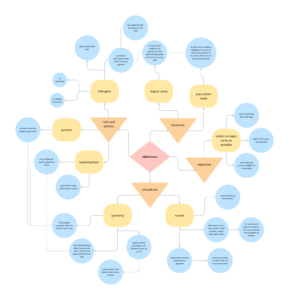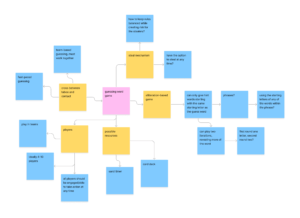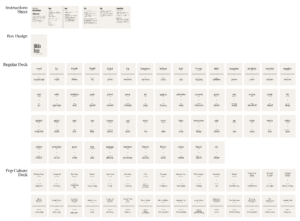Created by Krain Chen, John Altankhuyag, and Sammy Puckett
Artist’s Statement
Biblio Buzz is an alliterative word game designed to test your vocabulary and ability to think on your toes! Inspired by games such as Charades, Taboo, Anomia, and Contact, Biblio Buzz differentiates itself through its focus on alliteration and engaging playstyle. Players compete in teams to guess as many individual words (each printed on a separate card) as possible within a time limit, where one team member must guess keywords while all other members provide them hints. The twist? Players can only give one-word hints that start with the same letter as the word on their drawn card.
The design for our package and card design comes from newspapers, books, and traditional print publications. The serif fonts, cream-grey color scheme, and minimalistic design all speak to this inspiration. Our desire for a fresh, sophisticated look that differentiates our game from others like Taboo and Anomia stems from the game’s more challenging and “bookish” mechanics where the hints must all be alliterative.
At the heart of Biblio Buzz is our belief that fun, challenging games are best when made simple. Through this game, we hope to encourage players to think outside of the box, build connections with their fellow team members, and discover a love for language.
Concept Map

Ideation Exploration

Formal Elements and Values: Initial Decisions
Players and team structure
When initially working through our concept, we decided to lean intentionally into building a party game, and therefore wanted to prioritize building player fluidity into our design. As such, we tried to make our game enjoyable for a very large range of group sizes. Even though the ideal number of players is 4 – 10, the game can be played by much larger groups, and could theoretically include more than two teams if needed.
Resources
In order to keep the game as accessible as possible, we wanted to minimize the number of resources required to play, thus simplifying our resources down to just a deck of cards. Because the game itself is designed to be easily playable wherever, whenever (especially in casual settings or on-the-go), we needed players to be able to carry around the printed resources with very little forethought, in the same way that many people absentmindedly carry around a standard card deck. This meant keeping our point system simple insofar as each card being worth one point, therefore avoiding the need for score sheets or more complex methods of scorekeeping.
Guessing system
We wanted to create a guessing system that is naturally collaborative while also competitive, as we felt that party games are best enjoyed when you are always both relying on and competing with someone. As such, we decided to create two competing teams, such that players can naturally and actively build rapport with each other. Additionally, we wanted our guessing system to be very simple in concept and tricky in practice, thus the alliteration-based rules (based off of our own experiences with word games). Initially starting with one hint-giver and multiple guessers, we later decided to switch to multiple hint-givers and one guesser after gameplay was proven to be far more dynamic under the latter system.
Stealing system
Our main concern when starting to design our game was how to keep all players engaged throughout gameplay. Although we all personally enjoy a variety of word games, we shared frustrations around how most are structured to not actively engage all players at all times. As such, we decided to implement a stealing mechanic, such that while the active team is giving hints and guessing, the opposing team has one chance per card to steal a guess. Not only does this steal mechanism allow the opposing team to be involved, but it also ups the stakes for their involvement, thus requiring players to either communicate with each other or forfeit a turn. Additionally, the stealing mechanic allows players to learn from each other when being less active, therefore giving players time to revise their own strategies.
Rounds
In our quest to keep players as engaged as possible, we considered a number of round structures, hoping to hit the sweet spot for game length in order to avoid boring our players. We decided that capping the game at the number of rounds needed for each person to play every role (hint-giver, guesser, opposing team member) was ideal. Initially, we set each round at 3 minutes, modeled after Charades, however later moved to 2 minutes in an effort to make gameplay feel more dynamic.
Testing and Iteration History
Playtest v 1.0
- Who playtested: Group of four students in class, people did not know each other well
- What we were testing: Initial check on how the game will function, the difficulty of game, fun factor
- What went well: The stealing mechanic and timer kept all players very engaged and immersed in the experience. Playtesters had positive feedback about the fun factor!
- What didn’t go well: Playtesters found the game very difficult. Struggled a lot with some non-standard words. Experienced confusion about rules and words.
- Main takeaways:
- Playtesters had difficulty with the game rules and word clarification
- Some players felt defeated about being stuck on words
- Pace of play was slower than we expected. The limited passing of words stalled the game
- New idea: Special category cards, like pop culture
Playtest v 2.0
- Major changes: Physical rule sheet, parts of speech on cards, multiple hint-givers instead of one, infinite passing, new “Pop Culture” cards
- Who playtested: Group of friends in dorm, knew each other well
- What we were testing: Replay value of game for a friend group, effects of new changes
- What went well: With the rule sheet and parts of speech, there was much less confusion about rules and words than the first playtest. Stealing and timer kept both groups in competitive spirit and actively participating in every part of the game. The players really enjoyed the new “Pop culture” category and seemed to have a lot of fun and competition. Playtesters seemed sad that there weren’t more cards to go through.
- What didn’t go well: Players felt bad about wasting steal opportunities, went through the deck quickly with the infinite passing mechanic and wanted more cards.
- Main takeaways:
- Playtesters seemed to have a lot of fun! Especially with the pop culture cards, came up with very creative ways to hint at movies, celebrities, games etc. Rated game solid 8s and 9s out of 10.
- The stealing mechanic continued to keep players engaged, playtesters had big reactions to successful steals.
- Multiple hint-givers improved the pace a lot since players are less likely to get stuck
- Having the hint-givers hold the deck made them give up too early on words at times, causing them to burn through the deck too quickly
Playtest v 3.0
- Major changes: More words, drawing cards instead of holding the deck
- Who playtested: Group of four students in section
- What we were testing: Refining the game, the changes from v 2.0
- What went well: Players came up with lots of unique ways to give hints. They seemed to have a lot of fun with the steal mechanic. Pacing improved a lot with drawing cards instead of holding.
- What didn’t go well: Playtesters had a lot of concern about the replay value of the game, and mentioned playing the same words would be redundant.
- Main takeaways:
- The game has a lot of room for new strategies and metas. Adds a lot of replay value to the game
- However, the game structure makes it hard for the same group of players to play the same words again
- The steal mechanic is crucial to the game
Playtest Video
https://drive.google.com/file/d/18tNilgUVvmbdG1oZYeIqcp1ujp7_xX01/view?usp=drivesdk
Final Prototype
https://www.figma.com/file/7URsgJL2cph7h65ORldl9k/Biblio-Buzz-Game-(CS-247G)?node-id=13%3A6




